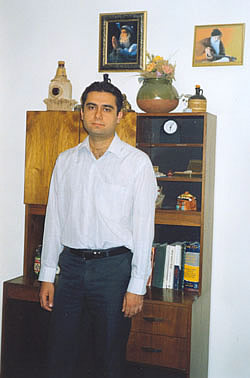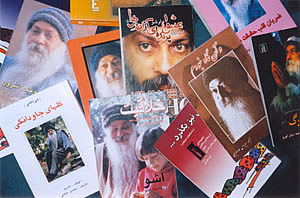Osho Entering Iranian
Hearts
 by
Arash
by
Arash
My name is Arash, and I am an Iranian sannyasin. Many of you may find it incredible that Osho’s waves of awareness and wisdom have managed to pass through the walls of ignorance and prejudice of this country, but this miracle has happened. In spite of all these limitations, Osho’s words and silence have entered our hearts. To explain how this happened, I’ll start with myself and tell you how Osho captured my being.
As a child I was taught to always be afraid, and that God was always watching me and reporting on me. As I grew up I began to understand that this so-called religion that I had been taught could not lead me to happiness, neither on earth nor in heaven. Finally I decided to put away all aspects of religion and otherworldly things. One day I said, “I want to be a materialist, so I can put all these fears away and make myself free of the chains of these saints and God.” But still I was not perfectly happy. I thought, “So what’s the aim of life?” Just growing, studying, having a job, making money, getting married, giving birth to a new human being, and dying, could not be that satisfying.
When I was 20, while my mom was weathering a crisis after divorcing my dad, she brought a book home with the title Only One Sky. She was so interested in this book, by an unknown author named Rajneesh, that she encouraged me to read it too. But I couldn’t connect with it; most of the subjects in it, like soul, meditation, and spiritual awareness, were strange to me. I asked her, “What is this nonsense you are reading?” I could see how much she had changed just by reading some sentences in a book, but I was very resistant toward any aspects of spirituality.
My mother then found a private class on Osho, His meditations and words, which was given in Tehran. She registered for the class and started learning some meditation techniques. She brought home another book by Osho, which was just a photocopy and not published yet. The title of the book was Life, Love, Laughter, and she asked me to read it. I opened the book and turned over the pages with reluctance. The first sentence that I read went something like, “I don’t call the person who doesn’t believe in God a materialist, and a religious man is not one who believes in God.” These words were so new and shocking to me, they made me want to read the book many times. Then, just to satisfy my curiosity, I asked my mother to register me for the classes. The class was held in a specially prepared room of the teacher’s house where I saw Osho’s photo for the first time. My teacher started to tell me about a meditation technique and about energy.
 Everything
was so funny for me, and I wanted to laugh at these pointless ideas. I
joined the class and did the meditations just to prove that nothing would
happen by doing them. I asked many questions, and I just wanted to argue
with the teacher. One day he said, “Okay, Arash. We will start a
new class and name it Mind Class. We will just talk, ask questions, and
dispute everything.” This sounded interesting and much more useful
to me!
Everything
was so funny for me, and I wanted to laugh at these pointless ideas. I
joined the class and did the meditations just to prove that nothing would
happen by doing them. I asked many questions, and I just wanted to argue
with the teacher. One day he said, “Okay, Arash. We will start a
new class and name it Mind Class. We will just talk, ask questions, and
dispute everything.” This sounded interesting and much more useful
to me!
The subject of the discussion was “helping others.” My teacher started to read an article on this topic, but I found it so different from what I had read in Osho’s books that I objected. My teacher turned over the book, and Osho’s name was written on it. I just stopped talking and kept silent. When the class was over, I went to my teacher and told him, “I have been so stupid. We cannot find reality in the books.” That was the first day I really realized that I was ready for change. But when my teacher emigrated to America, I no longer had any access to Osho sources.
In the meantime, two other Osho books had been published in Iran. One of them was Zendegi be revayate Buddha (Life: A Buddha’s Narration), which was a selection of Osho quotes, and the other one was Eshgh raghse zendegi (Love: The Dance of Life). The translator of this book also translated Life, Love, Laughter into Farsi, but the Ministry of Islamic Culture and Guidance, which is responsible for the supervision of any cultural activities in Iran, at first rejected this book. The publisher left out some discourses, added some more, and then got authorization to print this new version of the book. This book became so popular in Iran that it has already been reprinted ten times.
Now Osho was no longer an unknown name for Iranians, and His books were bestsellers. That encouraged other translators and publishers to translate more of Osho’s books into Farsi. Some other books arrived in the bookshops: Ah, This! and Words from a Man of No Words.
Because Osho’s books were becoming so popular, some parts of Iranian society – those who profit from people’s stupidity – started to oppose Him. They forced the Ministry of Islamic Culture and Guidance to forbid the sale of many of Osho’s books, and for a long time no new Osho book was published. But after a long period of time, the publishers got the required authorization to publish Osho’s books again. At that time, I thought that maybe by having a Web site on the Internet we could introduce Osho to more people. So I created the first Farsi Web site about Osho: www.persianosho.com.
Now we can communicate more easily with other Osho lovers in Iran and also with other Osho centers worldwide. Now 42 of Osho’s books have been published here, which is incredible considering the strictness and limitations we have. There are also some other Farsi Web sites with lots of information about Osho.
There is a thirst for meditation in Iran, but unfortunately, we don’t have any suitable places for meditation, and the only active meditation centers are Yoga centers. Yoga is considered to be just a physical technique for improving your health, with no spiritual aspect. There are some classes on Osho in Iran, held in the houses of sannyasins, but they mainly consist of reading Osho and talking about Him or His words.
We decided to invite a teacher who could teach us Osho meditations. After some correspondence, Swami Chaitanya Keerti from Osho World in Delhi accepted our invitation and traveled here at his own cost. That was the first time I had the chance to meet a person who has been in Osho’s presence and has received His divine energies. He helped us realize that meditation should be a simple part of life, like eating, laughing, or sleeping.
Iranians have a concept of meditation as something mysterious. The other important point he made was that there is no need or expectation for something strange or weird to happen. You just do the meditation, and everything will happen with no force or expectation.
We did some of Osho’s meditations – including Kundalini and Nataraj – and some of the friends who had joined the meditation did have some experiences, but Swami Keerti told us not to stop at this level. He said that the experiences were not important at all, that we may have many different experiences, but we should try not to focus on them. He taught us the meditation techniques and gave us some books, tapes, and meditation music. We have started meditating regularly and are trying to share this new way of life with all Iranian Osho lovers.
Osho finds new lovers here every day, and I am sure that this internal revolution will shine one day on the outside.
I would like to finish with some sentences from my beloved Master.
When you live with others, life has to follow certain rules. Those
rules are neither religious, nor moral, nor divine, they are just man-made.
One has to be aware of this, one has to know their relativity; they are
formal.
You need not break all the rules, there is no need, because then you will
be in unnecessary trouble, and rather than becoming a sannyasin you will
become a criminal. Remember that! A sannyasin is not a soldier, a sannyasin
is not a criminal; a sannyasin knows that rules are just a game. He is
not against them, he transcends them, he goes beyond them, he keeps himself
free of them. He follows them for others, but he doesn’t become
an automaton. He remains conscious and fully alert. Consciousness is the
goal.
When the Shoe Fits, Chapter 6